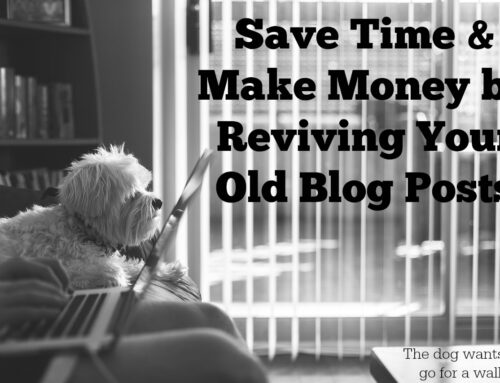 Step 4 – Monetize
Step 4 – Monetize
Now we get to the fun part. Before we worry about prettying things up, let's make sure this refreshed content will make us money. Ideally, each post and page on your website should serve a purpose. It could be that you're growing a list, building a relationship with your readers, just plain entertaining them, or selling them something.
For this report section, let's assume you want to make a living from your blog. In that case, you need your readers to either sign up for your list so you can market to them via email or make them an offer directly in the blog post.
If you chose to rework this particular blog post because you have the perfect product in mind to promote, this part would be easy. If not, take a few minutes and think about the purpose of this particular post. Do you want to encourage readers to sign up for your list? Or can you think of a product that would complement your content?
Take a few minutes to think about that and make a decision. Once you know what you want to promote or how you want to monetize your post, you can either write a call to action toward the end of your post or work your recommendation directly into the content.
If growing your list is your goal, try adding a call to action and a signup form at the end of your post. This signup form can be different from the one you have in your blog sidebar, and it should be so you can track where your signups are coming from. I find it helpful to craft a call to action directly related to the post's content.
Let me give you an example. Let's say I have a blog about raising toddlers and this particular post was about recognizing when your toddler is ready to potty train. My call to action at the end of this specific post would be something along the lines of:
I hope this was helpful, and I'd love to stay in touch. Of course, raising a toddler is about more than “just” potty training. Ready for more Toddler Tips? Enter your email below to sign up for the weekly Toddler Tips newsletter. I'll also send you my ten best tips for dealing with temper tantrums.
Notice how the call to action flows from the article’s content to what the weekly newsletter and opt-in freebie are about?
Another option is, of course, to promote a product in your post. There are a few different ways to do this. By far, the easiest method is to grab a graphic from the affiliate center (or a picture of your product) and stick it right in the middle of your content. That's also, by far, the least effective way to monetize your post. Another way you could monetize the post is by adding some code in there to display Google AdSense ads. Again, probably not your most effective way of monetizing your content – but it's better than nothing.
Even better is to do something similar to what we did with the call to action to sign up for our list. Toward the end of your blog post, transition to a recommended product and let them know why you think it's a good fit or why you think they should buy it.
Better yet, make your recommendations right in the content itself. Once you do that, it starts to make sense also to incorporate product pictures. This is particularly easy to do if you write a blog post where you're reviewing a product. As far as monetizing old content goes, it can make sense to work product recommendations directly into the content itself.
Let's go back to our potty training example. As you go through the various signs to look for that, let you know that your toddler is ready to be potty trained; mention that now would be the perfect time to order a potty seat. Then move into a product recommendation for your favorite potty seat available on Amazon.com, for example.
Ok, that's enough potty talk for now. I hope you've gotten some good ideas about monetizing your blog posts. Have another look through the post you're updating and figure out what you want to promote and how you want to monetize it.
If your primary goal is to grow your list, grab the code for a new opt-in form and write a solid call to action that invites readers to sign up.
If your main goal is to promote a related product, be it your own or something you're an affiliate for, think about how you want to incorporate it into your content. Grab your link and product images as needed and work them in.
Now that the old blog post is better monetized, let's move on to step five.
Step 5 – Make it Pretty
Now that we've updated the content and made sure it will make us money, let's make sure it looks good when our visitors come and visit the updated blog posts.
We'll break this section down into two different parts. The first is basic formatting, and the second one is adding images.
Formatting Your Blog Post
Having a well-formatted blog post has two significant benefits. It makes it easier to read, but it can also help with Search Engine Optimization. SEO is a big topic that's a bit out of the scope of this short report, but I think it's essential to mention it, at least here.
The basic idea behind SEO is to pick a keyword or key phrase you would like to rank for and then optimize your blog post around that phrase or keyword. Some of the ways to do this are:
- Using the keyword in your post title.
- Using the keyword in the URL of your post.
- Using the keyword or related terms in headings, bolded or italicized font.
- Using the keywords or related terms in the file names and alt tags of images on the page.
This is just a shortlist, but it shows you how a well-formatted post can help you get more free search engine traffic.
It bears repeating. Always write and format for your readers first, but keep the search engines in mind.
With that said, take a look at your content. Do a little keyword research if you didn't do this initially, and decide what you would like this particular post to rank for. Go through the list above and see if you include the keyword in most of those areas. Please don't change the URL because it will hurt you more in terms of search than help, and make sure your content still reads well. Don't stuff your keywords in there unnecessarily, and it will alienate your readers and may hurt you when it comes to organic search results.
Things like alt tags and image names are easy to add or change, and bolding a keyword here and there won't take more than a few seconds.
Back to formatting for your readers, though, since that's our main goal here. Make sure it is easy to scan your post. Can your readers get a pretty good idea of what it is about by reading the headline and any sub-headings you may have?
Are you breaking the text into small paragraphs to make it easy to read online? Are you using sub-headings and bullets to break things up and, again, make it easier to consume the information?
If not, work on that until you get the formatting where you want it. If you're not sure, ask a friend or fellow blogger to take a look at it for you. Don't worry if this seems hard at first. This process will become second nature after you reformat a few blog posts.
Adding or Updating Images
Let's wrap this section up by talking about images. Pictures are a great way to add interest to a page and enhance the content, and they are the perfect way to grab your reader's attention. And in the age of Facebook and Pinterest, you have to have images in your blog posts.
We'll go into a little more detail on social media in the next section, but for now, think about how you want to use images and how those images will appear when your post is shared on Facebook or Pinterest.
Different image sizes are recommended for Facebook vs. Pinterest, and in general, a horizontal image will do better in Facebook, while Pinterest seems to prefer vertical photos. Think about which social media platform is more important to you and your target market. Where does your traffic come from? A better question to ask is where your most profitable traffic comes from.
Once you know what social media site you want to focus on, optimize the image for that platform. It is usually helpful to text the image and thinks of it as yet another attention-grabbing headline in either situation.
Not sure what I'm talking about? Look at the example below or head on over to Pinterest.com and take a look at images that fellow bloggers have added.
Let's talk about a quick and easy way to create these images for your blog posts. The first thing you will need is a picture, and you can take your own or use stock photography.
Here are a few of my favorite stock photo sites that you may want to check out. Some provide free images, most you will have to pay for. Be sure to read the terms for each site and know what you can and can't do before publishing someone else’s picture or image.
Stock Photography Sites:
- MorgueFile.com
- Pixabay.com
- IStockPhoto.com
- BigStockPhoto.com
- DepositPhoto.com
Once you have your image from one of the sites above or your pictures, it's time to do a little editing. Don't worry. We're not talking about anything complicated here, and it doesn't involve expensive programs like Photoshop.
This is going to be fun and easy. A few sites out there allow you to do basic photo editing, and my personal favorite is PicMonkey.com. Just upload your image, change the size and resolution if needed and add some pretty text and other fun overlays and you're done.
Let's take a look at a before and after image. This is one of the images created to help promote the report. Here's how it started:
And after a bit of work in Picmonkey, it turned into this.
The PicMonkey.com image editor is very intuitive. Go ahead and give it a try. You'll also be able to find plenty of online tutorials on how to do all kinds of fun and fancy stuff. Just Google it or head on over to Youtube.com for some easy-to-follow tutorials.
Let's get back to what we are doing here. We want to enhance our content with one or two images that will make it easy to share on social media sites.
Think about what kind of image would go well with your content. Then decide if you want to take it yourself or find something you can use on one of the stock photography sites.
Got your picture? Take it over to PicMonkey.com and add an attention-grabbing headline. Save your work, and you're ready to upload the image to WordPress or the blogging software of your choice.
Embed the image into your blog post to make sense, and don't forget to save your changes.
Most of the hard work is done. There are just a few more steps we need to take to make sure we're getting the best possible results from all the hard work we've done editing, updating, and rewriting our content.
Step 6 – Is It Social Media Ready?
Let’s get back to something super simple. And since you’re blogging, the most significant chunk of work in step six is something you only need to do once. Our task is to make sure it is easy to share our updated (and new) content via social media.
When we talked about images, I asked you to consider what social media sites are most important to you. Where is your traffic coming from? Where are you finding your target audience? Where are you making money? These are the social media sites you want to focus on here.
I’m sure you’ve seen plenty of blogs that have an extensive huge list of social share buttons at the bottom of their post. Chances are, all those buttons aren’t doing much good. Instead, focus on your main two to three social media sites and make it easy for people to share.
Do you get a lot of traction from Twitter? Make sure you make it easy to tweet out little key snippets of text from your posts. Get good results from Facebook and have your content shared around? Put a big Facebook button on those posts. Do a lot of new readers and customers find you via Pinterest? Make sure you have pin buttons on all images and pay close attention to the alt tags on your images. The alt tags will become the default description for your pins. So be descriptive and inviting. Try a few different calls to action and see what gets you the most effective click-through rates.
Let’s break it down. There are two different types of work you’ve got to do here, and the first is to make sure you have the share buttons in place you need on your blog.
The second part is to pay attention as you create or revive your blog posts. Make sure your alt tags are descriptive for Pinterest. Make sure you pick good tweetable quotes for Twitter. And make sure your images and descriptions do well on Facebook. If you don’t like the text Facebook auto pulls from your posts, try adding a different one in the meta description box in WordPress.
Got it? Excellent – do that for your blog and the blog post you’re reworking right now, and I’ll meet you back here next week when you’re done for Chapter #3.
Need more local marketing tips? Check out our entire Guide to Local Marketing for Real Estate Professionals







